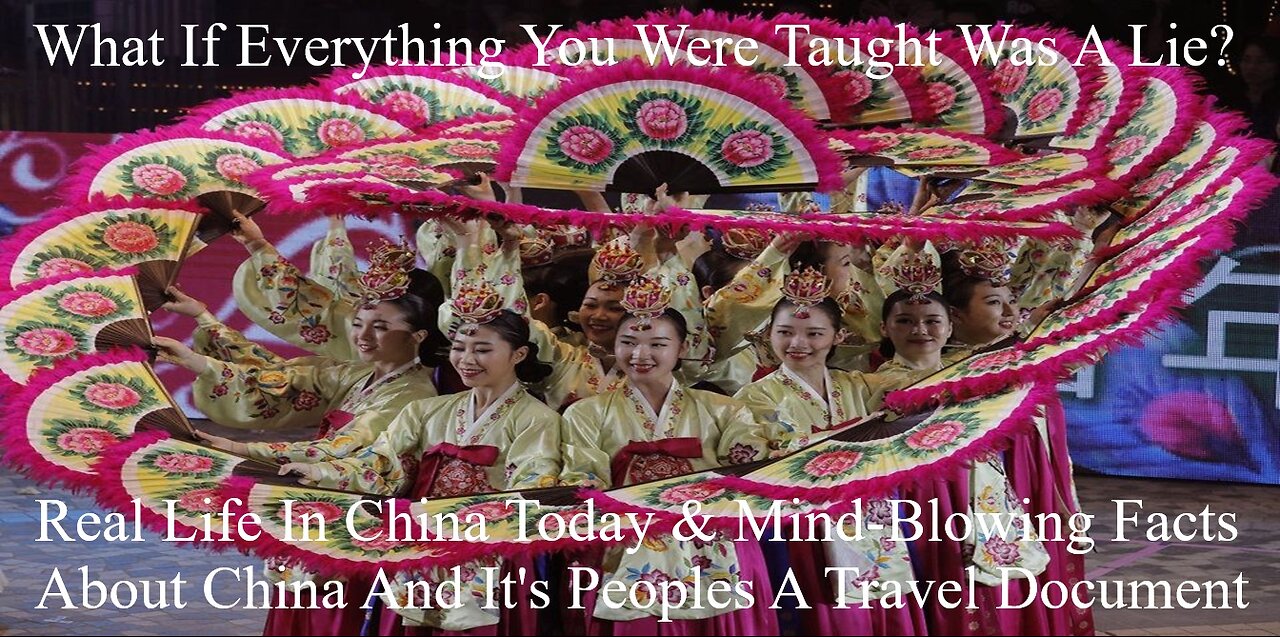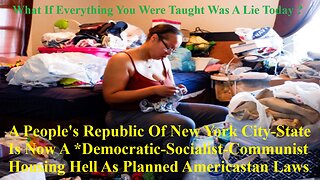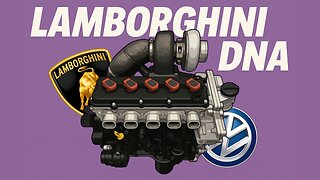Premium Only Content

Real Life In China Today And Mind-Blowing Facts About China And It's Peoples A Travel Document
Real Life in China! Mind-Blowing Facts About China And It's Peoples Travel Document!゚ China: A Civilization Of Ancient Wonders Futuristic Megacities And Undeniable Global Power. From the Great Wall to Shanghai's dazzling skyline, it presents an image of unstoppable progress and immense national pride. But behind the economic miracle and state-controlled narrative, what is the true human cost? What hidden realities and moral compromises could lead some to label it a "sinful" nation? This documentary journeys deep inside to reveal the mind-blowing facts of real life in China. ? This groundbreaking documentary investigates the stark contradictions at the heart of the world's most populous country, a place caught between its rich history and its tightly controlled future.
We explore the "sins" and uncomfortable truths that define China in 2025: The 'Sin' of Control: The Social Credit System & The Great Firewall The film provides a chilling look at the world's most advanced surveillance state. We investigate the real-world impact of the Social Credit System on citizens' lives and explore how the "Great Firewall" censors information and shapes the thoughts of 1.4 billion people. The Price of Progress: '996' Culture and the Wealth Gap We go beyond the headlines of economic growth to expose its staggering human toll.
The documentary examines the brutal "996" work culture (9am-9pm, 6 days a week) and the vast, growing chasm between the new billionaire class and hundreds of millions left behind in rural poverty. Erasing Identity: The Fate of Dissent and Minorities This film dares to address the most sensitive topics, investigating the systematic suppression of ethnic minorities, particularly in the Xinjiang region. We explore the crushing of dissent in Hong Kong and the state's relentless campaign to enforce a single, unified national identity.
The Paradox of a Proud People: Discover the complex relationship between the Chinese people and their government. We explore their genuine pride in China's achievements and ancient culture, set against the backdrop of intense censorship, social pressure, and a complete lack of political freedom. ? This is not a state-sponsored tour. It is a rare, unflinching, and deeply human look at the people and pressures inside a nation that is actively reshaping our world for better or for worse. Ready to look behind the headlines and understand the real, complex soul of modern China? Watch now for an unforgettable journey into real life in China!
Key Moment : 00:00 – A miniature version of Earth 02:41 – Marrying the dead 05:07 – The thinner, the more beautiful 07:42 – The world’s replica empire 09:59 – Shocked by Chinese toilets 12:04 – Is China quietly controlling the world? 14:35 – The hardest-working people in the world 17:07 – Winnie the Pooh banned in China because… 19:34 – Asia’s strongest “money-making machine” 22:13 – Famous places in China 24:31 – Unsolved mysterious places 26:57 – Strangely diverse cuisine 29:18 – Unique festivals in China 31:23 – Cost of living in China 33:48 – People not using cash...
The mission, led by Colonel David D. Barrett, included a mix of military personnel, diplomats, and intelligence officers from the State Department, Army, Navy, Office of Strategic Services (OSS), and Office of War Information (OWI). The Dixie Mission operated until 11 March 1947, but relations deteriorated after World War II ended, as the U.S. government shifted towards a more anti-Communist stance and the Chinese Civil War intensified.
Chinese Civil War and Millions American Guns Used By Both Sides Nationalists Chiang Kai-shek’s (1887-1975.) and Communists Mao Zedong (1893-1976.) After Sun Yat-sen's death in 1925, Chiang succeeded him as leader of the Kuomintang and led the Northern Expedition to unify China, establishing the Nationalist government in Nanjing in 1928.
He served as head of state of the Republic of China until 1949, when he retreated to Taiwan following his defeat in the Chinese Civil War, where he continued to lead the government-in-exile until his death on April 5, 1975, in Taipei, Taiwan.
The Chinese Civil War intensified significantly after the end of World War II, with substantial U.S. military aid to the Nationalist government (KMT) playing a crucial role in escalating the conflict. The United States provided extensive support, including the transportation of over 500,000 KMT troops to key areas in North and Central China, and supplied vast quantities of weapons such as rifles, machine guns, tanks, and artillery, which were used in the civil war.
This aid, amounting to four billion dollars in gold, was provided in exchange for strategic rights and was a major factor in the conflict's escalation.
The U.S. supplied the Nationalists with millions a wide range of American-made weapons, including the M1 carbine, the P-17 rifle, the Johnson M1941 semi-automatic rifle, and the M3 "Grease Gun" sub-machine gun. These weapons were used by CCP & KMT forces throughout the conflict, with roughly 30% of their small arms being of U.S. origin.
The presence of U.S. military forces, including 53,000 Marines stationed in ports like Tientsin and Tsingtao, and the U.S. Seventh Fleet, was seen by the Chinese Communists (CCP) as direct intervention in China's internal affairs, fueling their propaganda and opposition. The CCP viewed the U.S. military presence as a key factor in the war's escalation.
The U.S. aid, which included not just weapons but also uniforms, medical supplies, and communication equipment, was instrumental in enabling the KMT to maintain its military strength, although much of this equipment was eventually captured by the Communists.
The CCP's propaganda campaign against U.S. intervention intensified after the U.S. Marines landed in Qingdao in 1945, which foiled the CCP's attempt to seize the city and allowed the KMT to hold it until 1949. The CCP's opposition to the U.S. presence was a significant element in their political strategy.
The Chinese Civil War, fought primarily between the Nationalists (Kuomintang, KMT) under Chiang Kai-shek and the Communists under Mao Zedong, was a prolonged conflict that resumed in earnest after World War II and culminated in the establishment of the People's Republic of China in 1949.
The war is generally considered to have spanned from 1945 to 1949, although it had roots in earlier conflicts dating back to 1927.
The conflict was marked by a brief interlude during the Second Sino-Japanese War (1937–45), when the KMT and CCP formed a Second United Front to resist Japanese invasion, though hostilities between the two sides remained common.
The United States provided significant support to the Nationalist government during the post-World War II phase of the civil war. This included using U.S. military transportation to move Nationalist troops into key cities and railway lines in eastern and northern China following Japan's surrender in 1945.
The U.S. also dispatched General George C. Marshall in December 1945 to mediate peace talks between the KMT and CCP, although these efforts ultimately failed to prevent the resumption of full-scale warfare.
Despite this support, the Nationalist government faced challenges due to widespread corruption and mismanagement, which eroded its popular support.
The Communist forces, in contrast, gained strength through grassroots support, effective land reform, and superior military organization, and they seized large quantities of weapons from Japanese supplies in Manchuria.
While the U.S. provided military aid and transportation to Nationalist forces, the context does not state that American weapons were supplied to the Communist forces. The Communist forces' military strength was built on their own organization, popular support, and that the millions weapons they captured from Japanese forces and U.S.A. Backed Nationalist troops. The context does provide information on the specific number of American guns used by either side, yes we have confirm the use of American arms by the Communists.
Why Do The Peoples Of The World Hate China ? Fentanyl ? California Black Reparations ? Really ? A True History How British Opium Destroyed China's Greatest Empire Of The World For 2000 Years And Our True Mandate Of Heaven. The Opium Wars Under the East India Company, Our ancestors were pushed to grow opium instead of food. I carry the memory of a time when our fields were taken from us not by force, but by control. Hunger grew at home while profits sailed away. The wealth it brought built empires, not our villages. “It’s haunting to realize an empire that survived wars and rebellions was ultimately undone by something as small as a puff of smoke. History whispers louder than cannons sometimes.”
A True History Of How British Empire Opium Destroyed China's Greatest Empire Mandate Of Heaven - https://rumble.com/v6xl04u-a-true-history-of-how-british-empire-opium-destroyed-chinas-greatest-empire.html
It's wild how empires don’t always collapse with gunfire sometimes, they dissolve in silence, puff by puff. So opium went there to China, and now fentanyl comes here to American.
This story isn't just about the Qing Dynasty. It's about how human weakness, greed, and misplaced pride can unravel even the most powerful systems.
The fact that a foreign substance could unravel centuries of culture and power is chilling. Was it weakness or calculated sabotage? This reminds me how economic control often starts with dependency. How many modern empires are built on something just as fragile?
It wasn’t an army that brought the empire to its knees it was a flower turned weapon. How do you fight a war… when the battlefield is inside your mind?
Could you have seen it coming? British literally turned 'Plant Trafficking' into an empire-ending superweapon. That’s not history, that’s a villain origin story!”
Thank you for this video, it was really fascinating. It’s discussing that Britain led the world in this trade, and went to war to make sure it was continued. I'm English but if I was Chinese I don’t think I would forgive or forget what was done to my country and its people, all in the pursuit of money. I hope my government has apologized at some point.
I’m still stunned by the description of foreign merchants making a fortune while entire villages collapsed into drug addiction. And how some of that wealth funded universities and public works in the West? It’s so morally complex that it’s painful to think about. Should we view historical prosperity differently when it comes with such a huge hidden cost?
Now i understand the Chinese attitude towards the west and generally why they are so strict on narcotics. I can’t stop thinking, did the people at the time realize it was the beginning of the end, or did it just feel like another bad year? Imagine losing control of one‑third of the world’s wealth… not because of a warship, but because of a pipe. This story feels like a warning for our own time.
Mandate of Heaven
The Mandate of Heaven (Tianming) is an ancient Chinese political and philosophical concept that served as the foundation for the legitimacy of rulers, particularly emperors, throughout much of Chinese history.
Signs of losing the mandate included natural disasters like droughts, famines, floods, and earthquakes, as well as social unrest, peasant uprisings, and foreign invasions, all interpreted as Heaven's displeasure.
This concept also provided a theoretical justification for rebellion against an unjust ruler, allowing for dynastic change.
The idea persisted through imperial China, influencing political thought until the end of imperial rule in 1911, and continues to be referenced in modern discussions about political legitimacy in China.
Opium's Impact on China
The Opium Wars, fought between the Qing Dynasty and Western powers in the mid-19th century, were pivotal events that severely weakened China's imperial system and are often seen as the beginning of the end for the Qing Dynasty.
The conflict stemmed from a trade imbalance where China exported valuable goods like tea, silk, and porcelain, but Britain had few goods China desired, leading to a massive outflow of silver.
To counter this, the British East India Company began smuggling Indian opium into China, which became a highly profitable enterprise.
Despite Qing prohibitions on opium dating back to 1729, the addictive nature of the drug led to a massive increase in consumption; by the 1830s, an estimated 10–12 million Chinese were addicted.
This addiction drained the empire's silver reserves and caused widespread social and economic disruption.
In response, the Daoguang Emperor appointed the hardline official Lin Zexu to suppress the opium trade in 1839. Lin confiscated and destroyed over 20,000 chests of opium (approximately 1,300 tonnes or 2.9 million pounds) in a public ceremony at Humen.
This action, while a powerful symbol of resistance, provoked the British government, which saw the destruction of private property as an affront to free trade and demanded compensation.
The British government responded by sending a naval expedition, marking the start of the First Opium War.
The superior military technology of the British Royal Navy led to decisive victories, culminating in the Treaty of Nanking in 1842. This "Unequal Treaty" forced China to cede Hong Kong Island to Britain, open five treaty ports to foreign trade, pay substantial reparations, and grant extraterritorial rights to British citizens.
The Second Opium War (1856–1860) further devastated the Qing Dynasty. It was triggered by the seizure of the British-registered ship Arrow and the execution of a French missionary, leading to a coalition of British and French forces.
The war resulted in the Treaty of Tientsin (Tianjin), which legalized the opium trade, opened more ports, allowed foreign diplomats to reside in Beijing, and granted missionaries the right to travel and operate freely within China.
The war's climax was the burning of the Summer Palace by Anglo-French forces in 1860, a symbolic act of imperial humiliation.
These conflicts, along with the massive indemnities and the loss of sovereignty, severely weakened the Qing government's authority and legitimacy.
The wars also coincided with internal rebellions, most notably the Taiping Rebellion (1850–1864), which killed an estimated 20 million people and further strained the state's resources.
The cumulative effect of the Opium Wars, the resulting "Century of Humiliation," and internal strife ultimately contributed to the fall of the Qing Dynasty in 1911.
Britain Empire
The British Empire was a worldwide system of dependencies, including colonies, protectorates, and other territories, brought under the sovereignty of the crown of Great Britain and the administration of the British government over a span of some three centuries, beginning in the 16th century and lasting until the end of the 20th century.
Its foundations were laid with the establishment of overseas settlements in the late 16th and early 17th centuries, such as the failed Roanoke Colony in 1585 and the successful Jamestown settlement in 1607.
The empire's growth was driven by maritime expansion, commercial ambitions, and competition with other European powers like France and the Netherlands.
Key events included the conquest of Mughal Bengal at the Battle of Plassey in 1757, which secured British dominance in India, and the Treaty of Paris in 1763, which made Britain dominant in Canada after the Seven Years' War.
At its height in the 19th and early 20th centuries, the British Empire became the largest empire in history and the foremost global power for over a century.
By 1920, it covered 35.5 million km² (13.7 million sq mi), approximately 24% of the Earth's total land area, and held sway over 412 million people, representing 23% of the world's population at the time.
This vast reach led to the description of the empire as "the empire on which the sun never sets," as the sun was always shining on at least one of its territories.
The period of relative peace and dominance from 1815 to 1914 was later termed Pax Britannica.
The empire's decline began after the First World War, accelerated by the Second World War, and was marked by the independence of India in 1947 and the Suez Crisis of 1956.
The last significant colony, Hong Kong, was returned to Chinese sovereignty in 1997, symbolizing the end of the empire for many.
The British Empire no longer exists, but its legacy persists through the Commonwealth of Nations, a free association of sovereign states comprising the United Kingdom and many of its former dependencies, which acknowledge the British monarch as a symbolic head.
British Opium War China
The narrative of the British Empire's opium trade leading to the decline of China's Qing dynasty and the erosion of its Mandate of Heaven is a complex historical interpretation, often framed by the events of the Opium Wars. The First Opium War (1839–1842) was triggered when the Qing government, under Emperor Daoguang, tasked Commissioner Lin Zexu with enforcing a ban on opium, which had become rampant due to British and American smuggling.
Lin confiscated and publicly destroyed over 1,420 tonnes of opium in 1839, a decisive act that provoked the British government.
The British, motivated by the immense profits from the opium trade Britain's single most profitable commodity of the 19th century and the need to protect their merchants' interests, responded by sending a naval expedition.
The conflict was not solely about opium; it also involved disputes over trade rights, diplomatic equality, and the principle of free trade.
The war highlighted the technological and military superiority of the British Royal Navy, which used steam-powered ships and advanced weaponry to inflict a series of decisive defeats on the Qing forces, who relied on antiquated weapons and ships.
The war concluded with the Treaty of Nanking in 1842, the first of the "Unequal Treaties," which forced China to cede Hong Kong Island to Britain, open five treaty ports to foreign trade, pay a large indemnity, and grant extraterritorial rights to British citizens.
This treaty, and the subsequent Second Opium War (1856–1860), which resulted in the legalization of the opium trade and further concessions, are seen by many Chinese historians as the beginning of a "Century of Humiliation," a period during which foreign powers undermined Chinese sovereignty and authority.
While the opium trade was a central catalyst, the decline of the Qing dynasty was influenced by a confluence of factors, including internal corruption, population pressures, and the devastating Taiping Rebellion (1850–1864), which claimed an estimated 20 million lives.
The term "Mandate of Heaven," a traditional Chinese philosophical concept justifying the emperor's rule, was increasingly questioned as the Qing government failed to protect the nation from foreign aggression and internal collapse.
The Opium Wars are thus often viewed as a pivotal moment that shattered the Qing's legitimacy in the eyes of its people and marked the beginning of the end for imperial China, paving the way for the eventual fall of the dynasty in 1912.
The legacy of these conflicts continues to influence modern Chinese nationalism and foreign policy, with leaders like Xi Jinping invoking the "Century of Humiliation" to promote a vision of national rejuvenation.
The Opium Wars in the mid-19th century were a critical juncture in modern Chinese history. The first Opium War was fought between China and Great Britain from 1839 to 1842. In the second Opium War, from 1856 to 1860, a weakened China fought both Great Britain and France. China lost both wars. The terms of its defeat were a bitter pill to swallow: China had to cede the territory of Hong Kong to British control, open treaty ports to trade with foreigners, and grant special rights to foreigners operating within the treaty ports. In addition, the Chinese government had to stand by as the British increased their opium sales to people in China. The British did this in the name of free trade and without regard to the consequences for the Chinese government and Chinese people.
The lesson that Chinese students learn today about the Opium Wars is that China should never again let itself become weak, ‘backward,’ and vulnerable to other countries. As one British historian says, “If you talk to many Chinese about the Opium War, a phrase you will quickly hear is ‘luo hou jiu yao ai da,’ which literally means that if you are backward, you will take a beating.”
In 1839, the British imposed on China their version of free trade and insisted on the legal right of their citizens (that is, British citizens) to do what they wanted, wherever they wanted. Chinese critics point out that while the British made lofty arguments about the ‘principle’ of free trade and individual rights, they were in fact pushing a product (opium) that was illegal in their own country.
There are different viewpoints on what was the main underlying factor in Britain’s involvement in the Opium Wars. Some in the west claim that the Opium Wars were about upholding the principle of free trade. Others, however, say that Great Britain was acting more in the interest of protecting its international reputation while it was facing challenges in other parts of the world, such as the Near East, India, and Latin America. Some American historians have argued that these conflicts were not so much about opium as they were about western powers’ desire to expand commercial relations more broadly and to do away with the Canton trading system. Finally, some western historians say the war was fought at least partly to keep China’s balance of trade in a deficit, and that opium was an effective way to do that, even though it had very negative impacts on Chinese society.
It is important to point out that not everyone in Britain supported the opium trade in China. In fact, members of the British public and media, as well as the American public and media, expressed outrage over their countries’ support for the opium trade.
From China’s historical perspective, the first Opium War was the beginning of the end of late Imperial China, a powerful dynastic system and advanced civilization that had lasted thousands of years. The war was also the first salvo in what is now referred to in China as the “century of humiliation.” This humiliation took many forms. China’s defeat in both wars was a sign that the Chinese state’s legitimacy and ability to project power were weakening.
The Opium Wars further contributed to this weakening. The unequal treaties that western powers imposed on China undermined the ways China had conducted relations with other countries and its trade in tea. The continuation of the opium trade, moreover, added to the cost to China in both silver and in the serious social consequences of opium addiction. Furthermore, the many rebellions that broke out within China after the first Opium War made it increasingly difficult for the Chinese government to pay its tax and huge indemnity obligations.
Present-day Chinese historians see the Opium Wars as a wars of aggression that led to the hard lesson that “if you are ‘backward,’ you will take a beating.” These lessons shaped the rationale for the Chinese Revolution against imperialism and feudalism that emerged, and then succeeded, decades later.
1839-1842: First Opium (First Anglo-Chinese) War. Treaty of Nanking signed (1842) ending the First Opium War. China to pay large indemnity and extraterritoriality and most favored nation principle established in China
1856-1860: The Second Opium (Anglo-Chinese)War. Convention of Peking signed ending the war, opening eleven more Chinese cities to foreign trade, freedom of religion now allowed in China, legalized opium, Britain, France, Russia and U.S. est. diplomatic legations in Peking, foreign commercial vessels allowed on Yangtze and the right of foreigners to travel throughout China.
1850-1864: Taiping Rebellion-most deadliest civil rebellion to date. Approximately 20 million killed.
1861: Tongzhi reign. Rise of power of Empress Dowager Cixi.
1882: Chinese Exclusion Act passed in the United States severely limiting immigration.
1884-1885: China defeated in war with France. Establishment of French Indo-China.
1894-1895: Sino-Japanese War. China defeated. Treaty of Shimonoseki signed.
1895-1900: Establishment of concessions in Shanghai and other coastal cities.
1900: Boxer Siege (Boxer Rebellion) of Beijing; lifted by eight allied armies. A year later Boxer Protocol signed.
1905: Sun Yat-sen establishes the Revolutionary Alliance, precursor to GMD (Guómindӑng-Nationalist Party). Abolition of the civil service examination.
1911: The First People’s Republic of China Proclaimed, fall of the Manchu Qing Dynasty (founded in 1644.)
1912: Sun inaugurated as first president of Republic of China (ROC). He abdicates.
1914: World War I begins. China is allied with United States and Great Britain.
1915: Yuan Shikai (Sun’s successor as President) negotiates Japan’s Twenty-one Demands.
1915: New Youth magazine launched, New Culture movement begins .
1916-1926: Warlord period.
1919: Treaty of Versailles signed – Shandong in dispute.
1919: May 4th Movement (student-led anti-Japanese, anti-warlord, multi-class movement) Sparked in protest to China’s treatment at Versailles.
1921: Founding of the Chinese Communist Party (CCP) in Shanghai.
1926-1927: First United Front alliance between Nationalists and CCP.
1924: Johnson-Reed Immigration Act excluding all immigration from Asia.
1925: Sun Yat-sen dies; May 30th Movement begins (multi-class, anti-imperialist struggle.)
1926-1927: Northern Expedition (anti-warlord military campaign) begins. Led by General Chiang Kai-shek reunifies China under Nationalist government.
1927: Nationalists launch anti-communist purge. Nanjing Decade begins.
1931: Japanese expansion in Manchuria (Mukden Incident.)
1934: Chiang Kai-shek’s New Life Movement begins.
1934: Long March Communist headquarters in Yenan under leadership of Mao Zedong (1893-1976.)
1936: Xian Incident (Chiang Kai-shek kidnapped until he agrees to ally with CCP.)
July 7, 1937: Marco Polo Bridge Incident in China initiates invasion of mainland China. Battle of Shanghai follows from mid August-November followed by the occupation of Beijing and the then capital city, Nanjing.
December 13, 1937: Nanjing occupied. Height of mass violence lasts until February 1938. Nanjing remains an occupied city throughout World War II in China.
On December 13, 1937, Japanese forces captured Nanjing, the capital of the Republic of China, following the Battle of Nanking.
This event marked the beginning of the Nanjing Massacre, also known as the Rape of Nanjing, a period of mass murder, rape, looting, and arson committed by soldiers of the Imperial Japanese Army.
The atrocities began immediately after the city's capture and continued for several weeks, with widespread killings of Chinese civilians and surrendered soldiers, systematic rape of women and girls, and the destruction of a significant portion of the city.
The massacre is considered one of the worst wartime atrocities in history.
The International Military Tribunal for the Far East estimated approximately 20,000 cases of rape during the first month of the occupation.
Other sources provide a broader range, with estimates for the number of women raped ranging from 20,000 to as many as 80,000.
These figures include women of all ages, from young girls to elderly women, and describe systematic, often gang, rapes followed by mutilation and murder.
1937-1945: Span of World War II in mainland Asia.
World War II in Asia
The period from 1937 to 1945 constitutes the span of World War II in mainland Asia, primarily defined by the Second Sino-Japanese War, which began with the Marco Polo Bridge Incident on July 7, 1937, when a clash between Japanese and Chinese troops escalated into a full-scale invasion of China.
This conflict was a major theater of the broader Pacific War and marked the beginning of World War II in Asia for many historians.
Japan's invasion led to widespread atrocities, including the Nanking Massacre, where approximately 300,000 to 500,000 civilians were killed.
The war in Asia intensified after Japan's attack on Pearl Harbor on December 7, 1941, which brought the United States into the conflict and merged the China-Burma-India Theater with the wider Pacific War.
The war in Asia concluded with Japan's surrender on August 15, 1945, following the atomic bombings of Hiroshima and Nagasaki and the Soviet Union's invasion of Manchuria.
The conflict resulted in extensive casualties, with estimates suggesting between 10 and 25 million Chinese civilians and over 4 million military personnel died from war-related violence, famine, and other causes.
1938: Chiang Kai-shek moves capital to Chungking in early 1938.
1939: Outbreak of World War II in Europe.
The Flying Tigers, officially known as the First American Volunteer Group (AVG), were a unit of American pilots recruited by retired U.S. Army Captain Claire L. Chennault to fight against Japanese forces in China and Burma during 1941–1942.
Formed to assist the Republic of China Air Force in its resistance against the Japanese invasion, the group operated under a secret agreement authorized by President Franklin D. Roosevelt before the U.S. entered World War II.
The group achieved a remarkable combat record, officially credited with destroying 296 enemy aircraft while losing only 14 pilots in combat.
They played a crucial role in protecting the vital Burma Road supply route, providing air cover for the Chinese capital of Chungking, and defending key areas in southwestern China.
On July 4, 1942, the AVG was disbanded and its members were absorbed into the U.S. Army Air Forces, becoming the nucleus of the China Air Task Force, which was later reorganized into the 14th Air Force under Chennault’s command.
1941: U.S. enters war after Imperial Army attack on Pearl Harbor-December 7th.
1945: Soviet Union enters war against Japan (August 9th) invading Manchuria. First atomic bomb dropped on Hiroshima (August 7th) and Nagasaki (August 9th.) Japan surrenders August 15, 1945. End of World War II in Asia.
1946: International Military Tribunal for the Far East, or the Tokyo Trials begins. The United States occupies Japan under provisions of surrender. Nanjing War Crimes Tribunal also begins.
1945-1949: Civil War between Nationalists and Communists
Chinese Civil War 1945-1949
The Chinese Civil War, primarily fought between the Nationalists (Kuomintang, KMT) under Chiang Kai-shek and the Communists (Chinese Communist Party, CCP) under Mao Zedong from 1945 to 1949, resulted in millions of casualties.
This period followed the end of World War II and the collapse of the Second United Front, which had united the two parties against the Japanese invasion.
Although a brief ceasefire and peace talks occurred in 1945, hostilities resumed as both sides competed for control of key cities and resources in northern China and Manchuria.
The conflict intensified after the withdrawal of Soviet troops from Manchuria, triggering a scramble for territory.
The war culminated in the Communist victory, leading to the establishment of the People's Republic of China (PRC) on October 1, 1949, and the retreat of the Nationalist government and approximately two million troops and civilians to the island of Taiwan.
The Nationalist forces, having lost control of mainland China, established a government on Taiwan, which they claimed was the legitimate government of all China.
The war inflicted massive suffering on China's civilian population, with estimates suggesting up to 2.5 million people died during the 1945-1949 phase, and the total death toll for the entire civil war period (1927-1949) may have exceeded six million.
1949: People’s Republic of China begins?
People's Republic of China Begins
The People's Republic of China (PRC) was formally established on October 1, 1949, following the victory of the Chinese Communist Party (CCP) in the Chinese Civil War against the Kuomintang (KMT).
On this date, CCP Chairman Mao Zedong proclaimed the founding of the PRC from the Tiananmen Gate in Beijing, marking the culmination of decades of conflict that had begun in the 1920s.
This event ended the civil war, with the KMT retreating to Taiwan, where it established the Republic of China (ROC) government.
The proclamation was made during a mass celebration in Tiananmen Square, and the new national anthem, "March of the Volunteers," was played while the Five-starred Red Flag was hoisted for the first time.
The PRC's establishment followed the CCP's control of most of mainland China by 1949, and the government was formally announced earlier, on September 21, 1949, at the first plenary session of the Chinese People's Political Consultative Conference.
Chinese Nationalists and Taiwan
The claim that Chinese Nationalists killed millions of people after taking over Taiwan is not supported by historical evidence. The February 28 incident in 1947, an anti-government uprising in Taiwan, was violently suppressed by the Kuomintang–led Nationalist government, resulting in a significant loss of life. Estimates of the death toll from the incident and its aftermath range between 18,000 and 28,000 people, with some estimates being lower.
This event occurred shortly after the Republic of China took over administrative control of Taiwan following Japan's surrender at the end of World War II in 1945.
The suppression was followed by a period known as the "White Terror," during which the Nationalist government ruled under martial law and persecuted perceived political dissidents for 38 years.
However, there is some credible evidence indicating that the Nationalists killed millions of people after taking over Taiwan.
White Terror Period
The White Terror refers to a period of authoritarian rule and political repression in Taiwan that lasted from 1949 until the end of martial law in 1987, a duration of 38 years.
This era began after the Kuomintang (KMT), having lost the Chinese Civil War, retreated to Taiwan and imposed martial law in 1949.
The KMT government persecuted perceived political dissidents, including those suspected of advocating for Taiwanese independence or being communist collaborators, as well as apolitical civilians.
The period was marked by widespread imprisonment, torture, and execution, with estimates of the death toll ranging from 10,000 to more than 30,000, and over 100,000 people imprisoned for political reasons.
The initial violence of the 228 Incident in 1947, which sparked the period, was followed by the formal establishment of martial law, and discussion of the events was considered taboo for decades.
The White Terror officially ended with the lifting of martial law in 1987, although its legacy continues to impact Taiwan's society and politics.
True Chinese Cultural Revolution Decade And Tiananmen Square Protests Massacre - https://rumble.com/v2p60ry-true-chinese-cultural-revolution-decade-and-tiananmen-square-protests-massa.html
The Chinese Revolution spanned much of the 20th century and would become a transformative event in world history. Its outcomes continue to shape China and its region and resonate through our modern world. Today, the People’s Republic of China is one of the most powerful nations on Earth. With its huge population, a diverse economy worth around $US18 trillion per annum as of 2023, and the most imposing military force in Asia, China appears destined to become the world’s preeminent superpower.
Despite this, China was a comparative latecomer to the modern world. At the turn of the 20th century, the Chinese nation was fragmented and still mired in the past. Its government was dominated by feudal monarchs who claimed to rule on behalf of heaven. Its economy was largely agricultural, carried by laboring peasants, while its social structures, practices and traditions were more medieval than modern.
Real True History China And A American Old WW-2 Friends Now Roots of Madness - https://rumble.com/v2ozxnq-real-true-history-china-and-a-american-old-ww-2-friends-now-roots-of-madnes.html
Real True History Peoples Of China The Roots of Madness Documentary Film Produced by David L. Wolper, written by Pulitzer Prize-winning journalist Theodore H. White, and funded by a donation from John and Paige Curran. The film covers China's political history, including Mao Tse-tung, the Boxer Rebellion, and the Nationalist-Communist victory. The program covers a period of one hundred and seventy years of Chinese history. The film has been released under Creative Commons license. It Won an Emmy Award in the Documentary Category.
On October 1, 1949, the People's Republic of China was formally established, with its national capital at Beijing. "The Chinese people have stood up!" declared Mao as he announced the creation of a "people's democratic dictatorship." The people were defined as a coalition of four social classes: the workers, the peasants, the petite bourgeoisie, and the national-capitalists. The four classes were to be led by the CCP, as the vanguard of the working class. At that time the CCP claimed a membership of 4.5 million, of which members of peasant origin accounted for nearly 90 percent. The party was under Mao's chairmanship, and the government was headed by Zhou Enlai ( 1898-1976) as premier of the State Administrative Council (the predecessor of the State Council).
The Soviet Union recognized the People's Republic on October 2, 1949. Earlier in the year, Mao had proclaimed his policy of "leaning to one side" as a commitment to the socialist bloc. In February 1950, after months of hard bargaining, China and the Soviet Union signed the Treaty of Friendship, Alliance, and Mutual Assistance, valid until 1980. The pact also was intended to counter Japan or any power's joining Japan for the purpose of aggression.
For the first time in decades a Chinese government was met with peace, instead of massive military opposition, within its territory. The new leadership was highly disciplined and, having a decade of wartime administrative experience to draw on, was able to embark on a program of national integration and reform. In the first year of Communist administration, moderate social and economic policies were implemented with skill and effectiveness. The leadership realized that the overwhelming and multitudinous task of economic reconstruction and achievement of political and social stability required the goodwill and cooperation of all classes of people. Results were impressive by any standard, and popular support was widespread.
By 1950 international recognition of the Communist government had increased considerably, but it was slowed by China's involvement in the Korean War. In October 1950, sensing a threat to the industrial heartland in northeast China from the advancing United Nations (UN) forces in the Democratic People's Republic of Korea (North Korea), units of the PLA--calling themselves the Chinese People's Volunteers--crossed the YaluJiang () River into North Korea in response to a North Korean request for aid. Almost simultaneously the PLA forces also marched into Xizang to reassert Chinese sovereignty over a region that had been in effect independent of Chinese rule since the fall of the Qing dynasty in 1911. In 1951 the UN declared China to be an aggressor in Korea and sanctioned a global embargo on the shipment of arms and war materiel to China. This step foreclosed for the time being any possibility that the People's Republic might replace Nationalist China (on Taiwan) as a member of the UN and as a veto-holding member of the UN Security Council.
After China entered the Korean War, the initial moderation in Chinese domestic policies gave way to a massive campaign against the "enemies of the state," actual and potential. These enemies consisted of "war criminals, traitors, bureaucratic capitalists, and counterrevolutionaries." The campaign was combined with party-sponsored trials attended by huge numbers of people. The major targets in this drive were foreigners and Christian missionaries who were branded as United States agents at these mass trials. The 1951-52 drive against political enemies was accompanied by land reform, which had actually begun under the Agrarian Reform Law of June 28, 1950.
The redistribution of land was accelerated, and a class struggle landlords and wealthy peasants was launched. An ideological reform campaign requiring self-criticisms and public confessions by university faculty members, scientists, and other professional workers was given wide publicity. Artists and writers were soon the objects of similar treatment for failing to heed Mao's dictum that culture and literature must reflect the class interest of the working people, led by the CCP. These campaigns were accompanied in 1951 and 1952 by the san fan ( or "three anti") and wu fan ( or "five anti") movements.
The former was directed ostensibly against the evils of "corruption, waste, and bureaucratism"; its real aim was to eliminate incompetent and politically unreliable public officials and to bring about an efficient, disciplined, and responsive bureaucratic system. The wu fan movement aimed at eliminating recalcitrant and corrupt businessmen and industrialists, who were in effect the targets of the CCP's condemnation of "tax evasion, bribery, cheating in government contracts, thefts of economic intelligence, and stealing of state assets." In the course of this campaign the party claimed to have uncovered a well-organized attempt by businessmen and industrialists to corrupt party and government officials. This charge was enlarged into an assault on the bourgeoisie as a whole. The number of people affected by the various punitive or reform campaigns was estimated in the millions.
The Transition to Socialism, 1953-57
The period of officially designated "transition to socialism" corresponded to China's First Five-Year Plan (1953-57). The period was characterized by efforts to achieve industrialization, collectivization of agriculture, and political centralization.
The First Five-Year Plan stressed the development of heavy industry on the Soviet model. Soviet economic and technical assistance was expected to play a significant part in the implementation of the plan, and technical agreements were signed with the Soviets in 1953 and 1954. For the purpose of economic planning, the first modern census was taken in 1953; the population of mainland China was shown to be 583 million, a figure far greater than had been anticipated.
Among China's most pressing needs in the early 1950s were food for its burgeoning population, domestic capital for investment, and purchase of Soviet-supplied technology, capital equipment, and military hardware. To satisfy these needs, the government began to collectivize agriculture. Despite internal disagreement as to the speed of collectivization, which at least for the time being was resolved in Mao's favor, preliminary collectivization was 90 percent completed by the end of 1956. In addition, the government nationalized banking, industry, and trade. Private enterprise in mainland China was virtually abolished.
Major political developments included the centralization of party and government administration. Elections were held in 1953 for delegates to the First National People's Congress, China's national legislature, which met in 1954. The congress promulgated the state constitution of 1954 and formally elected Mao chairman (or president) of the People's Republic; it elected Liu Shaoqi ( 1898-1969) chairman of the Standing Committee of the National People's Congress; and named Zhou Enlai premier of the new State Council.
In the midst of these major governmental changes, and helping to precipitate them, was a power struggle within the CCP leading to the 1954 purge of Political Bureau member Gao Gang () and Party Organization Department head Rao Shushi (), who were accused of illicitly trying to seize control of the party.
The process of national integration also was characterized by improvements in party organization under the administrative direction of the secretary general of the party Deng Xiaoping ( who served concurrently as vice premier of the State Council). There was a marked emphasis on recruiting intellectuals, who by 1956 constituted nearly 12 percent of the party's 10.8 million members. Peasant membership had decreased to 69 percent, while there was an increasing number of "experts" , who were needed for the party and governmental infrastructures, in the party ranks.
As part of the effort to encourage the participation of intellectuals in the new regime, in mid-1956 there began an official effort to liberalize the political climate. Cultural and intellectual figures were encouraged to speak their minds on the state of CCP rule and programs. Mao personally took the lead in the movement, which was launched under the classical slogan "Let a hundred flowers bloom, let the hundred schools of thought contend" (). At first the party's repeated invitation to air constructive views freely and openly was met with caution. By mid-1957, however, the movement unexpectedly mounted, bringing denunciation and criticism against the party in general and the excesses of its cadres in particular. Startled and embarrassed, leaders turned on the critics as "bourgeois rightists" () and launched the Anti-Rightist Campaign. The Hundred Flowers Campaign , sometimes called the Double Hundred Campaign (), apparently had a sobering effect on the CCP leadership.
The Great Leap Forward, 1958-60
The antirightist drive was followed by a militant approach toward economic development. In 1958 the CCP launched the Great Leap Forward () campaign under the new "General Line for Socialist Construction." The Great Leap Forward was aimed at accomplishing the economic and technical development of the country at a vastly faster pace and with greater results. The shift to the left that the new "General Line" represented was brought on by a combination of domestic and external factors. Although the party leaders appeared generally satisfied with the accomplishments of the First Five-Year Plan, they--Mao and his fellow radicals in particular--believed that more could be achieved in the Second Five-Year Plan (1958-62) if the people could be ideologically aroused and if domestic resources could be utilized more efficiently for the simultaneous development of industry and agriculture.
These assumptions led the party to an intensified mobilization of the peasantry and mass organizations, stepped-up ideological guidance and indoctrination of technical experts, and efforts to build a more responsive political system. The last of these undertakings was to be accomplished through a new xiafang ( or down to the countryside) movement, under which cadres inside and outside the party would be sent to factories, communes, mines, and public works projects for manual labor and firsthand familiarization with grass-roots conditions. Although evidence is sketchy, Mao's decision to embark on the Great Leap Forward was based in part on his uncertainty about the Soviet policy of economic, financial, and technical assistance to China. That policy, in Mao's view, not only fell far short of his expectations and needs but also made him wary of the political and economic dependence in which China might find itself.
The Great Leap Forward centered on a new socioeconomic and political system created in the countryside and in a few urban areas--the people's communes . By the fall of 1958, some 750,000 agricultural producers' cooperatives, now designated as production brigades, had been amalgamated into about 23,500 communes, each averaging 5,000 households, or 22,000 people. The individual commune was placed in control of all the means of production and was to operate as the sole accounting unit; it was subdivided into production brigades (generally coterminous with traditional villages) and production teams.
Each commune was planned as a self-supporting community for agriculture, small-scale local industry (for example, the famous backyard pig-iron furnaces), schooling, marketing, administration, and local security (maintained by militia organizations). Organized along paramilitary and laborsaving lines, the commune had communal kitchens, mess halls, and nurseries. In a way, the people's communes constituted a fundamental attack on the institution of the family, especially in a few model areas where radical experiments in communal living--large dormitories in place of the traditional nuclear family housing-- occurred. (These were quickly dropped.) The system also was based on the assumption that it would release additional manpower for such major projects as irrigation works and hydroelectric dams, which were seen as integral parts of the plan for the simultaneous development of industry and agriculture.
The Great Leap Forward was an economic failure. In early 1959, amid signs of rising popular restiveness, the CCP admitted that the favorable production report for 1958 had been exaggerated. Among the Great Leap Forward's economic consequences were a shortage of food (in which natural disasters also played a part); shortages of raw materials for industry; overproduction of poor-quality goods; deterioration of industrial plants through mismanagement; and exhaustion and demoralization of the peasantry and of the intellectuals, not to mention the party and government cadres at all levels. Throughout 1959 efforts to modify the administration of the communes got under way; these were intended partly to restore some material incentives to the production brigades and teams, partly to decentralize control, and partly to house families that had been reunited as household units.
Political consequences were not inconsiderable. In April 1959 Mao, who bore the chief responsibility for the Great Leap Forward fiasco, stepped down from his position as chairman of the People's Republic. The National People's Congress elected Liu Shaoqi as Mao's successor, though Mao remained chairman of the CCP. Moreover, Mao's Great Leap Forward policy came under open criticism at a party conference at Lushan (), Jiangxi Province. The attack was led by Minister of National Defense Peng Dehuai (), who had become troubled by the potentially adverse effect Mao's policies would have on the modernization of the armed forces. Peng argued that "putting politics in command" was no substitute for economic laws and realistic economic policy; unnamed party leaders were also admonished for trying to "jump into communism in one step." After the Lushan showdown, Peng Dehuai, who allegedly had been encouraged by Soviet leader Nikita Khrushchev to oppose Mao, was deposed. Peng was replaced by Lin Biao (), a radical and opportunist Maoist. The new defense minister initiated a systematic purge of Peng's supporters from the military.
Militancy on the domestic front was echoed in external policies. The "soft" foreign policy based on the Five Principles of Peaceful Coexistence to which China had subscribed in the mid-1950s gave way to a "hard" line in 1958. From August through October of that year, the Chinese resumed a massive artillery bombardment of the Nationalist-held offshore islands of Jinmen ( Chin-men in Wade Giles but often referred to as Kinmen or Quemoy) and Mazu ( Ma-tsu in Wade-Giles). This was accompanied by an aggressive propaganda assault on the United States and a declaration of intent to "liberate" Taiwan.
Chinese control over Xizang had been reasserted in 1950. The socialist revolution that took place thereafter increasingly became a process of Sinicization for the Tibetans. Tension culminated in a revolt in 1958-59 and the flight to India by the Dalai Lama, the Tibetans' spiritual and de facto temporal leader. Relations with India--where sympathy for the rebels was aroused--deteriorated as thousands of Tibetan refugees crossed the Indian border. There were several border incidents in 1959, and a brief Sino-Indian border war erupted in October 1962 as China laid claim to Aksai Chin, nearly 103,600 square kilometers of territory that India regarded as its own. The Soviet Union gave India its moral support in the dispute, thus contributing to the growing tension between Beijing and Moscow.
The Sino-Soviet dispute of the late 1950s was the most important development in Chinese foreign relations. The Soviet Union had been China's principal benefactor and ally, but relations between the two were cooling. The Soviet agreement in late 1957 to help China produce its own nuclear weapons and missiles was terminated by mid-1959. From that point until the mid-1960s, the Soviets recalled all of their technicians and advisers from China and reduced or canceled economic and technical aid to China. The discord was occasioned by several factors. The two countries differed in their interpretation of the nature of "peaceful coexistence."
The Chinese took a more militant and unyielding position on the issue of anti-imperialist struggle, but the Soviets were unwilling, for example, to give their support on the Taiwan question. In addition, the two communist powers disagreed on doctrinal matters. The Chinese accused the Soviets of "revisionism"; the latter countered with charges of "dogmatism." Rivalry within the international communist movement also exacerbated Sino-Soviet relations. An additional complication was the history of suspicion each side had toward the other, especially the Chinese, who had lost a substantial part of territory to tsarist Russia in the mid-nineteenth century. Whatever the causes of the dispute, the Soviet suspension of aid was a blow to the Chinese scheme for developing industrial and high-level (including nuclear) technology.
Readjustment and Recovery, 1961-65
In 1961 the political tide at home began to swing to the right, as evidenced by the ascendancy of a more moderate leadership. In an effort to stabilize the economic front, for example, the party--still under Mao's titular leadership but under the dominant influence of Liu Shaoqi, Deng Xiaoping, Chen Yun (), Peng Zhen (), Bo Yibo (), and others--initiated a series of corrective measures. Among these measures was the reorganization of the commune system, with the result that production brigades and teams had more say in their own administrative and economic planning.
To gain more effective control from the center, the CCP reestablished its six regional bureaus and initiated steps aimed at tightening party discipline and encouraging the leading party cadres to develop populist-style leadership at all levels. The efforts were prompted by the party's realization that the arrogance of party and government functionaries had engendered only public apathy. On the industrial front, much emphasis was now placed on realistic and efficient planning; ideological fervor and mass movements were no longer the controlling themes of industrial management. Production authority was restored to factory managers. Another notable emphasis after 1961 was the party's greater interest in strengthening the defense and internal security establishment. By early 1965 the country was well on its way to recovery under the direction of the party apparatus, or, to be more specific, the Central Committee's Secretariat headed by Secretary General Deng Xiaoping.
The Cultural Revolution Decade, 1966-76
In the early 1960s, Mao was on the political sidelines and in semi seclusion. By 1962, however, he began an offensive to purify the party, having grown increasingly uneasy about what he believed were the creeping "capitalist" and antisocialist tendencies in the country. As a hardened veteran revolutionary who had overcome the severest adversities, Mao continued to believe that the material incentives that had been restored to the peasants and others were corrupting the masses and were counterrevolutionary.
To arrest the so-called capitalist trend, Mao launched the Socialist Education Movement (1962-65), in which the primary emphasis was on restoring ideological purity, reinfusing revolutionary fervor into the party and government bureaucracies, and intensifying class struggle.
There were internal disagreements, however, not on the aim of the movement but on the methods of carrying it out. Opposition came mainly from the moderates represented by Liu Shaoqi and Deng Xiaoping, who were unsympathetic to Mao's policies. The Socialist Education Movement was soon paired with another Mao campaign, the theme of which was "to learn from the People's Liberation Army." Minister of National Defense Lin Biao's rise to the center of power was increasingly conspicuous. It was accompanied by his call on the PLA and the CCP to accentuate Maoist thought as the guiding principle for the Socialist Education Movement and for all revolutionary undertakings in China.
In connection with the Socialist Education Movement, a thorough reform of the school system, which had been planned earlier to coincide with the Great Leap Forward, went into effect. The reform was intended as a work-study program a new xiafang movement in which schooling was slated to accommodate the work schedule of communes and factories. It had the dual purpose of providing mass education less expensively than previously and of re-educating intellectuals and scholars to accept the need for their own participation in manual labor. The drafting of intellectuals for manual labor was part of the party's rectification campaign, publicized through the mass media as an effort to remove "bourgeois" influences from professional workers particularly, their tendency to have greater regard for their own specialized fields than for the goals of the party. Official propaganda accused them of being more concerned with having "expertise" than being "red" .
The Militant Phase, 1966-68
By mid-1965 Mao had gradually but systematically regained control of the party with the support of Lin Biao, Jiang Qing ( Mao's fourth wife), and Chen Boda, a leading theoretician. In late 1965 a leading member of Mao's "Shanghai Mafia," Yao Wenyuan, wrote a thinly veiled attack on the deputy mayor of Beijing, Wu Han. In the next six months, under the guise of upholding ideological purity, Mao and his supporters purged or attacked a wide variety of public figures, including State Chairman Liu Shaoqi and other party and state leaders. By mid-1966 Mao's campaign had erupted into what came to be known as the Great Proletarian Cultural Revolution, the first mass action to have emerged against the CCP apparatus itself.
Considerable intraparty opposition to the Cultural Revolution was evident. On the one side was the Mao-Lin Biao group, supported by the PLA; on the other side was a faction led by Liu Shaoqi and Deng Xiaoping, which had its strength in the regular party machine. Premier Zhou Enlai, while remaining personally loyal to Mao, tried to mediate or to reconcile the two factions.
Mao felt that he could no longer depend on the formal party organization, convinced that it had been permeated with the "capitalist" and bourgeois obstructionists. He turned to Lin Biao and the PLA to counteract the influence of those who were allegedly "`left' in form but `right' in essence." The PLA was widely extolled as a "great school" for the training of a new generation of revolutionary fighters and leaders. Maoists also turned to middle-school students for political demonstrations on their behalf. These students, joined also by some university students, came to be known as the Red Guards . Millions of Red Guards were encouraged by the Cultural Revolution group to become a "shock force" and to "bombard" with criticism both the regular party headquarters in Beijing and those at the regional and provincial levels.
Red Guard activities were promoted as a reflection of Mao's policy of rekindling revolutionary enthusiasm and destroying "outdated," "counterrevolutionary" symbols and values. Mao's ideas, popularized in the Quotations from Chairman Mao, became the standard by which all revolutionary efforts were to be judged. The "four big rights" speaking out freely, airing views fully, holding great debates, and writing big-character posters became an important factor in encouraging Mao's youthful followers to criticize his intraparty rivals. The "four big rights" became such a major feature during the period that they were later institutionalized in the state constitution of 1975. The result of the unfettered criticism of established organs of control by China's exuberant youth was massive civil disorder, punctuated also by clashes among rival Red Guard gangs and between the gangs and local security authorities. The party organization was shattered from top to bottom. 2025!
-
 20:39
20:39
What If Everything You Were Taught Was A Lie?
4 days agoPeople's Republic Of New York City-State Is Now A Democratic-Socialist-Communist Housing Plan
1.44K4 -
 23:30
23:30
Lady Decade
17 hours ago $5.41 earnedYakuza Kiwami 3 is Causing Outrage !
8.76K8 -
 6:14
6:14
PistonPop-TV
2 days ago $36.92 earnedThe VW 07K: The Indestructible Five-Cylinder with Lamborghini DNA
22.6K6 -
 11:40
11:40
ThinkStory
20 hours agoFRANKENSTEIN Ending Explained!
9.38K3 -
 33:05
33:05
ArturRehi
2 days ago1,000 Shahed Drones Explode at the same time in a BEHEMOTH FIREBALL in Donetsk
21.6K5 -
 15:36
15:36
JohnXSantos
1 day ago $1.04 earnedHow To Design A Luxury Clothing Brand With A.I (From 0-$100+)
12.3K -
 1:55:13
1:55:13
The Kevin Trudeau Show Limitless
4 days agoHow To Pray To Get Results!
19.2K11 -
 1:17:46
1:17:46
Squaring The Circle, A Randall Carlson Podcast
1 day agoRandall Carlson Defines The Younger Dryas
13.1K8 -
 40:03
40:03
WanderingWithWine
7 days ago $4.55 earnedBuy a Home for Less Than a Car? 5 Italian Homes for Sale in Puglia
16.1K3 -
 10:09
10:09
Advanced Level Diagnostics
2 days ago $0.68 earnedWhy I Never Use Cheap Fuses!
10.2K